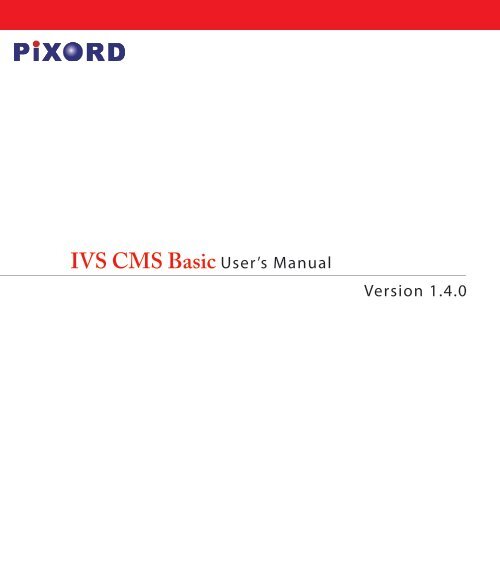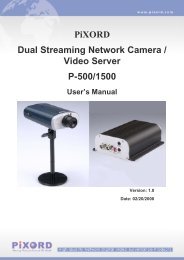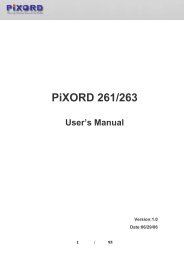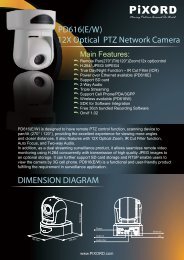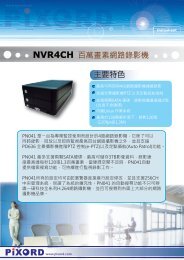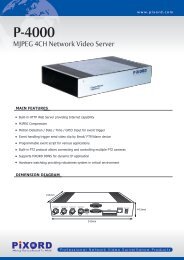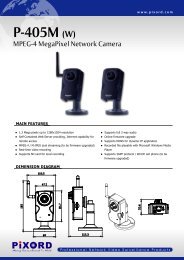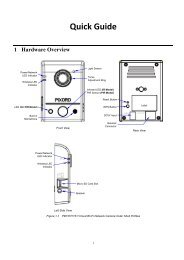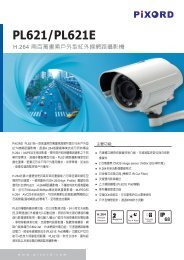IVS CMS Basic User's Manual Version 1.4.0 - Pixord
IVS CMS Basic User's Manual Version 1.4.0 - Pixord
IVS CMS Basic User's Manual Version 1.4.0 - Pixord
Create successful ePaper yourself
Turn your PDF publications into a flip-book with our unique Google optimized e-Paper software.
<strong>IVS</strong> <strong>CMS</strong> <strong>Basic</strong> User’s <strong>Manual</strong><strong>Version</strong> <strong>1.4.0</strong>
Terms and ConditionsThis End-user License Agreement is a legally binding agreement between you (either an individualor a single entity) and our company for the software product, which may include associatedsoftware components, media, printed materials, and online or electronic documentation.By installing, copying, or otherwise using the product covered by this EULA, you agree to bebound by the terms of this EULA. If you do not agree to the terms of this EULA, do not installor use the product, instead you may return it, within 30 days, along with all associated materialto your place of purchase for a full refund. The product is protected by copyright laws andinternational copyright treaties, as well as other intellectual property laws and treaties. Notethat the product is licensed to you, not sold. The license you have been granted is identifiedby the Software License Code on the License Certificate.* Installation and Use *The company hereby grants you the right to install and use the software product with thefollowing restrictions:1. The product may be installed on as many computers that meet the hardware and softwarerequriements.2. The product may only be used on computers running operating systems for which the productwas designed.3. You can and may only use the product in connection with video hardware equipment forwhich you have rightfully obtained the corresponding Device License Keys from our authorizeddealer or from our company’s web site* Copyright *All titles, including but not limited to copyrights, in and to the software product and anycopies thereof are owned by our company. All rights not expressively granted are reserved byour company.* No Warranties *The company expressly disclaims any warranty for the product. The software product andany related documentation is provided as is without warranty of any kind, either express orimplied, including, without limitation, the implied warranties or merchantability, fitness for aparticular purpose, or non-infringement.3user’s manual
The entire risk arising out of use or performance of the software product remains with you asthe user. You are notified that the product, when used with certain equipment or other software,may enable you to perform surveillance actions and data processing which are likelyto be restricted by or contrary to applicable law, including without limitation data privacy andcriminal law. The sole responsibility for verification of your use against compliance with applicablelaw lies with you as the user.* Limitation of Liability *The provisions of this paragraph are in effect to the maximum extent permitted by applicablelaw. In no event shall the original manufacturer or its suppliers be liable for any special, incidental,indirect, or consequential damages whatsoever (including, without limitation, damagesfor loss of business profits, business interruption, loss of business information, or anyother pecuniary loss) arising out of the use of or inability to use the software product or theprovision of or failure to provide proper support, even if our company has been advised of thepossibility of such damages. Absent any willful misconduct or gross negligence, the originalmanufacturer's entire liability under any provision of this agreement shall be limited to theamount actually paid by you for the product.* Miscellaneous *(a) You may make as many copies of the software product as may be necessary for backupand archival purposes.(b) You may distribute copies of the software product to third parties.(c) You may not reverse engineer, decompile, or disassemble any of the software product’scomponents except to the extent permitted by applicable law which cannot be contractuallywaived.(d) You may permanently transfer all of your rights for this product, provided the recipientagrees to the terms of this agreement.* Termination *Without prejudice to any other rights, our company may terminate this license agreementif you fail to comply with its terms and conditions. In such event you must destroy all copiesof the software product.* Governing Law *These License Terms and the contract between you and our company are governed by Taiwaneselaw and the sole and proper forum for the settlement of disputes hereunder shall bethe Taiwan Shihlin District Court.4user’s manual
Minimum System RequirementsHardware requirement:• CPU: P4-2.4Ghz or Dual Core and above• RAM: Minimum 1 GB, 2GB or above is recommended• HDD: SATA 200GB or above is recommended• Display card: Independent display card suggested• Make sure your display DPI setting is set todefault at 96DPI• To set DPI value, right-click on desktop,choose “Settings” tab >> “Advanced”>> “General”• Ethernet interface: 10/100Mb Ethernet card or aboveSoftware requirement:• OS: Windows 2000(SP4), Windows XP, Windows20035USER’S MANUAL
User Interface Overview1Live VideoThis is the section where the live videosare displayedMenu BarThis is where all functions can beaccessedQuick AccessQuick access buttonsto certainfunctions that youcan do to a livevideoSystem LogsDisplay system status informationPTZ ControlControl the PTZ cameraSystem InfoDisplay the system informationSplit Video WindowsSwitch among differentwindow split modesLive Video: This is where all the videos are displayed.You can decide what channels’ videos to bedisplayed here by dragging cameras from the sidemenu bar and dropping them anywhere in this section.Menu Bar: This is where you can access all functionsof the software. Camera list and device status informationare also available from the menu bar.6User’s manual
PTZ Control: This is where you can pan, tilt, zoomthe selected PTZ camera. Functions such as presetpoint nevagation and auto pan can also be accessedhereSystem Info: It provides information of currentsystem time, who is currently logged in and the CPUusage that the software is currently consuming.Split Video Windows: You can change the video splitwindows with you desire depends on how many videosyou wish to view at a time.System Logs: System status such as motion detection,functions that were accessed or settings thatwere altered are displayed here.Quick Access: Each video window comes with quickaccess buttons which allows you to quickly take certainactions to the video you are viewing.7Chapter 1 User Interface Overviewuser’s manual
InstallationBegin InstallationThe installation should launch as soon as you insertthe CD. If not, simply double-click on your CD-ROMdrive icon in “My Computer” to launch the installer.2Once the installer is launched, it should start bychecking the compatibility with the operating systemyou are running this installation on.Once the compatibility check is passed, you can beginthe installation by clicking “next”.8User’s manual
The installer will install the program in a pre-defineddirectory. You can accept the default and click “Next”to proceed with the installation.The installer will confirm the installation directoryone more time. Click “Install” to begin installation, orclick “Back” to change the installation directory.9Chapter 2 Installationuser’s manual
The installer will display the installation process.Once the installation is complete, click “Finish” toexit out the installer.Chapter 2 Installation10user’s manual
Change Installtion DirectoryIf you wish to install the program other than itspre-defined directory, click “Change” at the promptwhere it displays the pre-defined directory,You will be prompted with a new window in whichyou can type in the new directory at the bottom.Or you can choose the directory from the drop downmenu.11Chapter 2 Installationuser’s manual
If you need to install in a folder that doesn’t existyet, click “Create New Folder” to create it.Start the <strong>CMS</strong> softwareAfter the prgram is successfully installed on the PC,there are two ways to start it.• Start it from the “Start” menu:Simply go to “Start” >> “All Programs” >> “<strong>IVS</strong>” >>“<strong>CMS</strong> <strong>Basic</strong>”• Start it from the desktop:The program automatically creates a shortcut icon onyour desktop after it’s successfully installed. Simplydouble-click the icon to launch the program.* You should run the “Setup Wizard” beforelaunching the <strong>CMS</strong> software. The Setup Wizard isa separate program which you can launch it thesame way you launch the <strong>CMS</strong> software (fromStart menu). The purpose of the Setup Wizard isto help users with certain preliminary settings inorder for the program to work withNVR networkvideo recorder.Chapter 2 Installation12user’s manual
Using the Setup Wizard3Menu options --Lists all the menuoptions available inthe Setup WizardConfiguration Window --Displays configurationparameters of the selectedmenu optionIt’s necessary to use the WizardThe majority of the settings of the <strong>CMS</strong> software relieson its Setup Wizard. It’s necessary that you runthe wizard prior to using the <strong>CMS</strong> software.With the Setup Wizard, you are able to:• Add/Remove/Edit one or more NVRs• Configure PTZ preset points• Configure Motion Detection• Configure user privileges• Configure how events are handled• Configure E-map• Configure multiple monitors• Configure event actions13user’s manual
Add a NVR4NVRNVR16CHConnect the program with NVRThe main purpose of the <strong>CMS</strong> software is to manage multipleNVRs. Before it can be done, you would need to tell theprogram which NVR you need it to manage. You do that byadding one or more NVRs to the program through the SetupWizard.Automatic Search:The Setup Wizard is able to find NVR on your local networkautomatically. Simply go to “NVR Settings” >> “<strong>Manual</strong>Settings” in the Setup Wizard, and click the search button tolocate NVRs that are placed on your local network.14User’s manual
Drag and Drop to addOnce the Setup Wizard detects NVR on the network,they will be listed in the “Detect List”. Simply dragone from the list and drop it in the “Advance ControlList” below to add itNNVRNYou will then be prompted with its username andpassword which you need to enter accordingly tocomplete the action.Add NVR <strong>Manual</strong>ly with Setup Wizard:Simply click on the “Add NVR” button in the samepage to add it manually.NVR15Chapter 4 Add a NVRuser’s manual
You will be asked for the information shown belowbefore successfully adding the NVR to the program.Remove a NVR or Edit its SettingsOnce you have one or more NVR added to the program, the“Remove” and “Edit Settings” buttons will become available.Simply click to select a NVR from the list on the left andchoose the corresponding button on the right.NVR 1NVR 2Remove NVREdit settingsChapter 4 Add a NVR16user’s manual
PTZ Configuration5Select NVR andcameraSelect whichNVR and whichcamera from thedrop-down listPTZ PresetPoints ListList of all PTZpreset pointsof the selectedcameraVideo PreviewYou canget a videopreview ofthe selectedcamera herePTZ SpeedControlAdjust theincrementof the PTZmovementsPTZ Preset Point NameAdd a new name or alter an existingname of a preset pointPTZ Control PanelUse this panel to define a newpreset point or make change to anexisting oneSynchronize or Add New PTZ Preset PointsYou can synchronize PTZ settings from all cameras connected toSVR-116 on the network or you can create and add new PTZ presetpoints to those cameras through the Setup Wizard.Select a NVR firstSimply select a NVR from the drop-down menu firstand then select a camera to synchronize or add newPTZ preset points.Then select a cameraconnected toNVR 1NVR 1the selected NVRN17user’s manual
Configuring PTZ Preset SequenceYou can configure the PTZ preset sequence after you createand define PTZ preset points for the cameras. To configurePTZ sequence, open the setup wizard and go to NVR setting>> PTZ Config >> PTZ sequenceSet Dwell TimeFinally set the dwelltime for sequencingview among eachpointYou can see a list of the preset points that were addedpreviously under the “Preset info” pane on the left(see below step 3), which you can then move onesto the right (Preset Sequence pane) for sequenceviewing6.1.2.5.3. 4. 5.Select an NVR firstSelect an NVR fromthe drop down menufirstSelect a PTZ CameraSelect a PTZ camerato configure PTZ sequenceSelect Preset PointsThe previously configuredpreset points willbe listed on the leftMove the ones to the rightMove the preset points tothe list on the right usingthe which they will beused for PTZ sequencingAdjust Sequence OrderYou can use theor buttons toadjust the sequenceorders19user’s manual
To enable motion detection to certain cameras, draga camera from the device list and drop it on to themotion detection enable list.The camera will then show up in the motion detectionenable list. You can then set sensitivity of themotion detection.Click “Set” to display the video in the video previewwindow in which you can define an area for motiondetection.21Chapter 6 Motion Detectionuser’s manual
Users and Groups7Users and Groups ConfigurationThe section allows users to add new users and customizeeach of their access privilege by assigningthem to different user groups. The purpose of thisfunction is to limit the number of people to have accessto the program, hence, having access to viewlive videos, playback videos or altering settings ofthe program.Once you add users to the program, you will beprompted to enter the username and password of avalid user account.* There is no user account configuredfor the program by default.The privileges of the “Admin” and the“Guest” groups are not configurableand the “Guest” account is configuredwith the “view only” privilege”.22User’s manual
Add a New UserTo add a new user, simply click on the “add newuser” button available at the upper-right hand cornerin the “User/Group Config” page.Add a new userThis opens up a new window for you to enter thedetail information of the user you are creating.* The “Username”, “Password” and“Confirm Password” fields are requiredwhen creating a new useraccount. The rest of the fields areoptional.* You can click the “Check” button tocheck if the username you are creatingfor the new account has beenused by another account.A “+” will appear next to the group indicating a userhas been added to that particular group. Click on the“+” to expand the group and all users will be displayed.23Chapter 7 Users and Groupsuser’s manual
The “Remove” and “Edit” buttons will become availableonce a user has been created.Click the “Remove” button to remove an existinguser, or the “Edit” button to edit setting of an existinguser accountRemove an userEdit setting of an existinguser accountEdit Group PrivilegeTo edit access privilege of a particular user group,simply select a group first then click the “Edit Group”button.Edit privilege of a goupChapter 7 Users and Groups24user’s manual
This opens up the the group privilege configurationdialog.Select a group from the drop-down menu and checkwhich function(s) this group has permission to.Select a groupSelect functions togrant access to25Chapter 7 Users and Groupsuser’s manual
Event Handling8General eventconditionsNVR-specificevent conditionsEvent Handling ConfigurationHere you can define what consititutes an event withpre-defined conditions and what actions to be takenwhen these conditions are met.The conditions are devided into two categories:• General event conditionsConditions such as settings being altered• NVR-specific event conditionsConditions such as motion detection26User’s manual
To enable a condition for event trigger, simply tickthe checkbox of a particular condition.Event ConditionTick the checkbox to enableDouble-click pulls down theevent serversEvent ServersTick the checkbox to enableDouble-click on any condition pulls down the eventservers which users can choose to use for that particularcondition.The event servers can be considered as actions thatare taken place when events are triggered.27Chapter 8 Event Handlinguser’s manual
Configure E-Map9Main MapThe main mapwhich displays locationsof all NVRsSub-mapsEach sub-map displaysthe near-byarea of a particularNVR which showslocations of allcameras connectedto itThe E-MapThe program provides two-layered e-map which thetop layer displays the location of all NVRs and thesecond layer (sub-map) displays locations of all camerasconnected to one NVR.* There are 16 sub-maps and one for each NVR.This function is particularly useful when motion detectionis configured. You can simply place the e-mapon one monitor and whenever there is motion detected,the NVR will be highlighted on the map andlive video will be displayed for live event monitoring.28User’s manual
Configuring The E-MapYou can replace the map of your own when configuringe-map.Simply double-click anywhere on the map to enlargeit.Double-click toenlarge the mapand double-click on the enlarged map again to openthe dialog which lets you locate the new map file.You will need to select a map file that is in the JPEGfile format.Double-click toreplace the mapLocate the new map file from the local computer29Chapter 9 Configure E-Mapuser’s manual
Once the new map is in place, move the red dots onthe map to define locations of each NVR.Drag and move thered dot to definelocation of a NVRClick the “Save” button at the upper-right hand cornerto save changes when you are done.Save settings* Use the same method described above to configure submapsfor each NVR.Chapter 9 Configure E-Map30user’s manual
Set up Multiple Monitors10Available monitorsFunction WindowsIf you have multiple monitors configured in the PC,the <strong>CMS</strong> setup wizard can automatically detect suchconfiguration and displays the available monitors.You can find that in the setup wizard under “GeneralSetting” >> “Screen Layout Config”.You should then see the available monitors on theright (Screen-1, Screen-2...etc).By default, all the function windows are set to displayon Screen-1.You can then drag the desired function window anddrop it to the monitor (ex. Screen-2) you wish it tobe displayed on.Drag and Drop31user’s manual
Event Servers11Event Servers are Event ActionsThe program provides four different event serversthat can be used when events are triggered.• Mail server• FTP server• Message server• Sound serverYou can add up to three for each servers and pickthe one(s) you would like to use for particularevent(s).You can get a configuration overview of all the eventservers under the “Event Action Config” page.32User’s manual
Configure Mail Server For EventsYou can configure up to three mail servers in whichyou can select later and use them for different eventtrigger conditions.When configuring an mail server, it’s essential thatyou provide the following information:• Mail server address (IP or FQDN domain name)• Username and password for the mail server (ifrequired)• Recipient’s e-mail addressTo start adding a mail server, click on an item fieldand the setting boxes should become availble.Enter the mail server information and click “Submit”to save the settings.You may click “Test” to verify the settings prior tosaving the configurations.Click to add or editEnter mail server info33Chapter 10 Event Serversuser’s manual
Configure FTP Server For EventsYou can configure up to three FTP servers in whichyou can select later and use them for different eventtrigger conditions.When configuring an FTP server, it’s essential thatyou provide the following information:• FTP server address (IP or FQDN domain name)• FTP server port (such as port 21)• Username and password for the FTP server (ifrequired)• Path to upload the files to (if not / directory)To start adding an FTP server, click on an item fieldand the setting boxes should become availble.Enter the FTP server information and click “Submit”to save the settings.You may click “Test” to verify the settings prior tosaving the configurations.Click to add or editEnter FTP server infoChapter 10 Event Servers34user’s manual
Configure Message Server For EventsYou can configure up to three message servers inwhich you can select later and use them for differentevent trigger conditions.When configuring a message server, it’s essentialthat you provide the following information:• Message server address (IP or FQDN domainname)• Message server port• Username and password for the Message server(if required)• Text to be broadcastedTo start adding a message server, click on an itemfield and the setting boxes should become availble.Enter the message server information and click “Submit”to save the settings.You may click “Test” to verify the settings prior tosaving the configurations.Click to add or editEnter messageserver info35Chapter 10 Event Serversuser’s manual
Configure Sound Server For EventsYou can configure the program to send warningsound from the system’s speaker when events aretriggered.To start adding a sound server, click on an item fieldand the setting boxes should become availble.Click to addor editClick on the “folder” icon to locate the sound file. Youmay select a sound file that is only in the WAV fileformat.Click to locatesound fileChapter 10 Event Servers36user’s manual
Accessing the main programNow that you have finished configuring the mainprogram through its setup wizard, after saving allthe settings (which you can do so by clicking on the“Save” button on the left pane tree menu), simplyclick “Exit” to close the Setup Wizard.To access the main program, simply click on “MainViewer” to exit the Setup Wizard and it will be openthe main program automatically.You can then access the main program by doubleclickingon the short cut icon located on the desktop.Or you can access the main program by simply go to“Start” >> “All Programs” >> “<strong>IVS</strong> Central <strong>Basic</strong>” >>“<strong>CMS</strong> <strong>Basic</strong>”37Chapter 10 Event Serversuser’s manual
Using the Main Program12Working with the Live Video PageThis page basically provides you the ability to view,and manage the video streams of each channel.The program provides certain functions which helpsusers to monitor effectively.• Video Function Bar• Side Menu Bar• View Window Switcher• System Information• PTZ Control38User’s manual
PTZ Control IndicatorYou are able to control one PTZ camera at a timeand this icon tells users which camera is currentlyselected for PTZ action.The video window will also be highlighted with bluecolor to indicate it’s currently being selected.PTZ icon shown inred meaning this isa PTZ camera, or itwould grayed out.* If the icon indicatesin red: Mouseover-videoPTZ isenabled.highlighted with bluecolorPTZ control indicator displays in green:digital PTZ is enabled* Digital PTZ function is only availble forthe “non-PTZ types of cameras)Using PTZ Control PanelOnce a video is selected for PTZ action (right-clickon a video to select), you are able to do the PTZwith the PTZ control panel,41Chapter 11 Using the Main Programuser’s manual
Use Mouse-over-video PTZor you can simply move the mouse onto the video,an arrow and the crosshair should be displayed.Simply right-click on the video to pan and tilt thecamera. Use the mouse scroll button to scroll downto zoom in and scroll up to zoom outright-click to pan andtilt, use mouse scrollbutton to zoom in/outDrag and Drop to Relocate VideosOn the live view page, you can simply drag the videoto re-arrange its location or switch location with anothervideo.Drag a video and dropit to a new locationDrag a video and switchplace with another videoChapter 11 Using the Main Program42user’s manual
View Window SwitcherYou can use this function to switch between differentview patterns and set up how videos are displayedon the screen.Support Two Full Screen ViewThe program supports two full screen view if thereare more than one monitors connected to the PC.You can view up to 16 live video on each full screenwith configurable view patterns.The first full screen displays videos infull screen with its current view patternlayout (if it’s displaying videos in a 6split window view, the same displays infull screen)The second full screen displays videosin full screen in a 16 split window bydefault. You can change the layout byright-click anywhere on the screen andmake selection from the drop-downmenu.43Chapter 11 Using the Main Programuser’s manual
Camera Tree ListYou can retrieve a list of the cameras and NVRs fromthe side menu bar. Simply click on the “TREE” menuto access this function.By default, only the NVRs are listed. You can doubleclickon any of them to retrieve the camera list ofthat NVR.You can then drag an NVR from the list and drop itonto the live video area, in which all cameras’ videoswill be displayed.You can also drag one camera from the list and dropit onto any video window to display video from thatcamera.Drag and drop an NVRDrag and drop a camera45Chapter 11 Using the Main Programuser’s manual
Sequence ViewThis is a useful tool which you can simply setup theprogram to display videos from certain or all camerasand the program will automatically switch viewsfor you. You can also set up the sequence intervaland decide how long you would like each video tostay on the screen.Select how videos are splittedon the live view areaSet sequence intervalChoose to sequence all cameras orselected ones only* The “Pattern SEQ” will not become availableuntil you create “patterns” under the “PATTERN”menu* The “Pattern SEQ” will not become availableuntil you create more than one patterns underthe “PATTERN” menuChapter 11 Using the Main Program46user’s manual
Live View Pattern GroupsYou can create multiple profiles for different live viewsplit layouts. This is a extreme useful function in alarger environments where you have many camerasin place and multiple cameras setup for each area.After the “patterns” are created, you can head backto the “SEQ” menu and enable the “Pattern SEQ”feature. This will ask the program to display videosfrom the “pattern” groups in sequence.To configure view pattern groups and set it for patternsequence view:1. Select a view layout first2. Then, select cameras from the camera tree listDrag and drop videos on the screen to arrange theirlocations as you desire.47Chapter 11 Using the Main Programuser’s manual
3. Click the “+” sign under the “PATTERN” menu toadd it3. Go back to the “SEQ” menu and select “PatternSeq” and the patterns should be available.Select the ones for sequence viewingChapter 11 Using the Main Program48user’s manual
Event Monitor13* This page can be displayed on another monitorThe Event Monitor is an advance live video monitortool that combines functions of• Single live video view from camera that’s triggeredwith events• Channel configuration information• Event log, search, playback• E-Map displays cameras’ locations which weretriggered with events49Video from thecamera that wastriggered witheventDetail informationof thecamera, such aschannel number,which NVR it’sconnected to...The location ofthe camera willbe displayed onthe E-Mapuser’s manual
Playback Events from Event MonitorThe program will log continuously when new eventsare triggered. Simply click on one to start playingback the video. Its corresponding configuration andlocaltion will also be displayed accordingy.Playback video Channel info Camera locationClick on oneto start playingback an oldeventFilter and Search EventsWhile the event logs keep stacking up the screen, it’sdifficult to look for a particular event for playback.You can then use the search function and filter thesearch result by either search from a event starttime, search by event type, or both.Double-click to openthe search dialogYou can also narrow the search results by performingsearch to a particular NVR.* The event triggerinterval is set at 10secondsChapter 12 Event Monitor50user’s manual
Playback14Playback searchPlayback videosRecorded events thumbnamilsPlayback controlsPlayback slider to jump to aparticular time of the currentplayback videos* This page can be displayed on another monitorThe program supports 4-channel syncronous playbackin a quad view layout. Search results thatinclude events will be marked in blue on the calendarand their corresponding event thumbnails will bedisplayed at the bottom to reduce the search timeand effort.Searching for Playback VideosTo start looking for playback videos, simply select anNVR from the drop-down menu first and select whichchannels to look for playbacks.Select an NVR firstSelect channels to perform search51user’s manual
Search results will then be displayed on the calendarindicating which days have recordings available.Days marked in darkgray means recordingsavailable (manual/schedule recordings)Days marked in bluemeans there are eventsbeing recordedClick on a day will shows what hours of that day recordingswere performed. Click on a particular hourto start playing back videos.If you click on an hour which event recordings wereperformed, the program will display the thumbnailsof the first frame from each trigger at the bottom.This is useful for users to help them quickly find thefootage that’s meaningful to them instead of fastwardingfew times.You can also use the time bar and go directly to aparticular start time.Chapter 13 Playback52user’s manual
Capture Snapshots of a Playback VideoThis is the same function that is available in the live viewpage. Each playback video windows comes with functionbar at the upper-right hand corner.AVI ExportCurrent status of thischannelCapture snapshot ofthe recorded videoTurn on/off audio fromthe recorded videoright-clickAVI ExportYou can export the recorded videos to AVI files andsave them onto a local hard disk. Simply click on the“AVI Export” icon while a video is being played back.Click it again to stop the process.• All exported videos are automatically saved in the “AVI” folderunder the program installation directory.“Ex.: C:\Program Files\<strong>IVS</strong>\<strong>IVS</strong> <strong>CMS</strong> <strong>Basic</strong>\AVI”• The program allows a maximum of one hour of video perchannel to be exported53Chapter 13 Playbackuser’s manual
E-Map Monitor15The E-Map provide a simple overview of whereevents are happening. This allows users to only payattention to what’s meaningful to them.This function comes with two layers of maps wherethe first layers represents locations of each NVR.This is normally referred as the main map which amap with overview of a larger scale area should beused.Once there’s an event triggered from a particularNVR, the location of the NVR will be circled in red tonotify users an event has been triggered.The video and event trigger type are also displayedon the map.54User’s manual
Double-click on the red dot (the location of the NVR)will take you to the sub map where the locations ofall the cameras within will be displayed.The camera of which the event is triggered from willbe circled in red to tell the user the location of theevent in a more detail manner.The sub map provides the PIP (Picture-in-Picture)view which the main map is embedded in the submap so that users can still know if there are eventsbeing triggered from other NVRs at the same time.Sub mapMain mapDouble-click to go back to main mapSimply double-clicking the embedded main map togo back to the main map view.55Chapter 14 Event Monitoruser’s manual
Service Mode16If you are using a PC that is not dedicated to run thisprogram only (working with some other programs atthe same time), you can turn on the service mode,which can be accessed from the side menu bar underthe “SYSTEM” menu, select “Service Mode”.This will minimize the program to the Windows systemtrayThe function to detect new NVR and event triggernotification will continuely to work in the background.You will get notification from the tray if the programhas detected a new NVR has been placed on thenetwork.A small video will also be popping out from the trayto notify you that an abnormal motion has been detected.56User’s manual
Right-click on the program tray icon gets you otherfunctions• Maximize the program• Close the main program and open the Setup Wizard• Turn on/off event notification (on by default)• Turn on/off NVR Smart Search (on by default)• Switch to synchronize events manually (off by default)• About the program• Exit the program57Chapter 15 Service Modeuser’s manual
Change Program Display LanguageThe program provides multiple languages user interface. Tochange the display language, go to the side menu and select“SYSTEM” >> “Language” and select a desired language fromthe drop-down menu.Check Program <strong>Version</strong>To check the program’s version, go to “SYSTEM” >> “<strong>Version</strong>”.58user’s manual
Check Camera and NVR StatusOn the live view page, each camera’s current status is displayedin the upper-right hand corner of the video windowYou can, however, obtain status of all NVRs and thecameras from the side menu under “STATUS”Status definition59user’s manual
M1210/EN/10227009/001


